The Impact of Technology on Healthcare Quality and Delivery
VerifiedAdded on 2022/11/30
|6
|1058
|292
Discussion Board Post
AI Summary
This discussion post explores the multifaceted impact of technology on healthcare quality. It delves into how advancements in medical technology, such as telemedicine, have improved patient care by enhancing communication between healthcare professionals and patients, particularly in remote areas. The post highlights the benefits of telemedicine in reducing hospitalizations and managing emergency situations, as well as its cost-effectiveness in addressing mental health complications like depression. Furthermore, it examines the role of technology in improving communication among nursing professionals and the use of electronic medical records to reduce medication errors. The discussion also touches upon wearable technologies and their impact on patient care, specifically in preventing falls and managing chronic conditions. The analysis is supported by evidence-based research, providing a comprehensive overview of technology's influence on various aspects of healthcare, from patient outcomes to the efficiency of healthcare delivery.
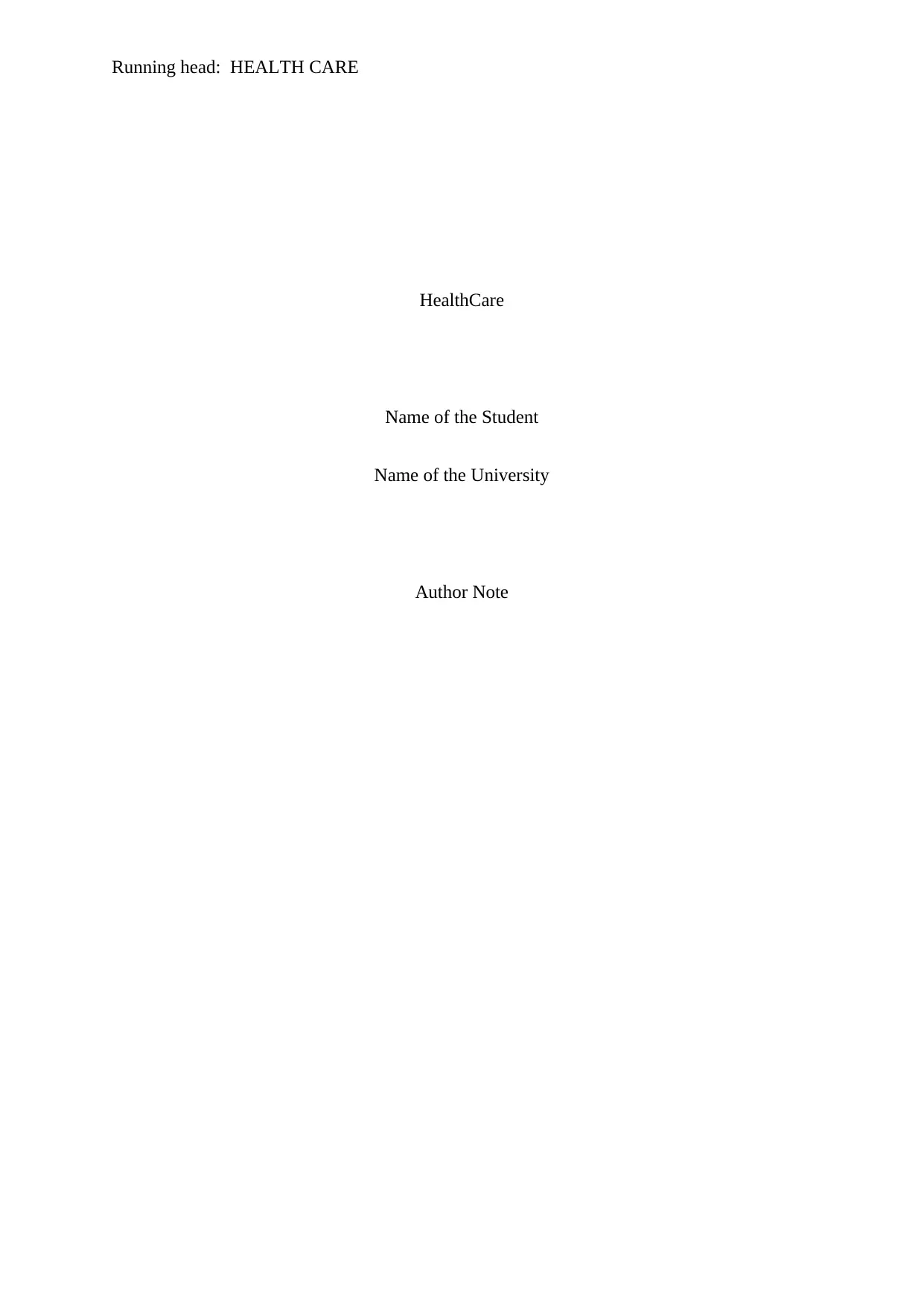
Running head: HEALTH CARE
HealthCare
Name of the Student
Name of the University
Author Note
HealthCare
Name of the Student
Name of the University
Author Note
Paraphrase This Document
Need a fresh take? Get an instant paraphrase of this document with our AI Paraphraser
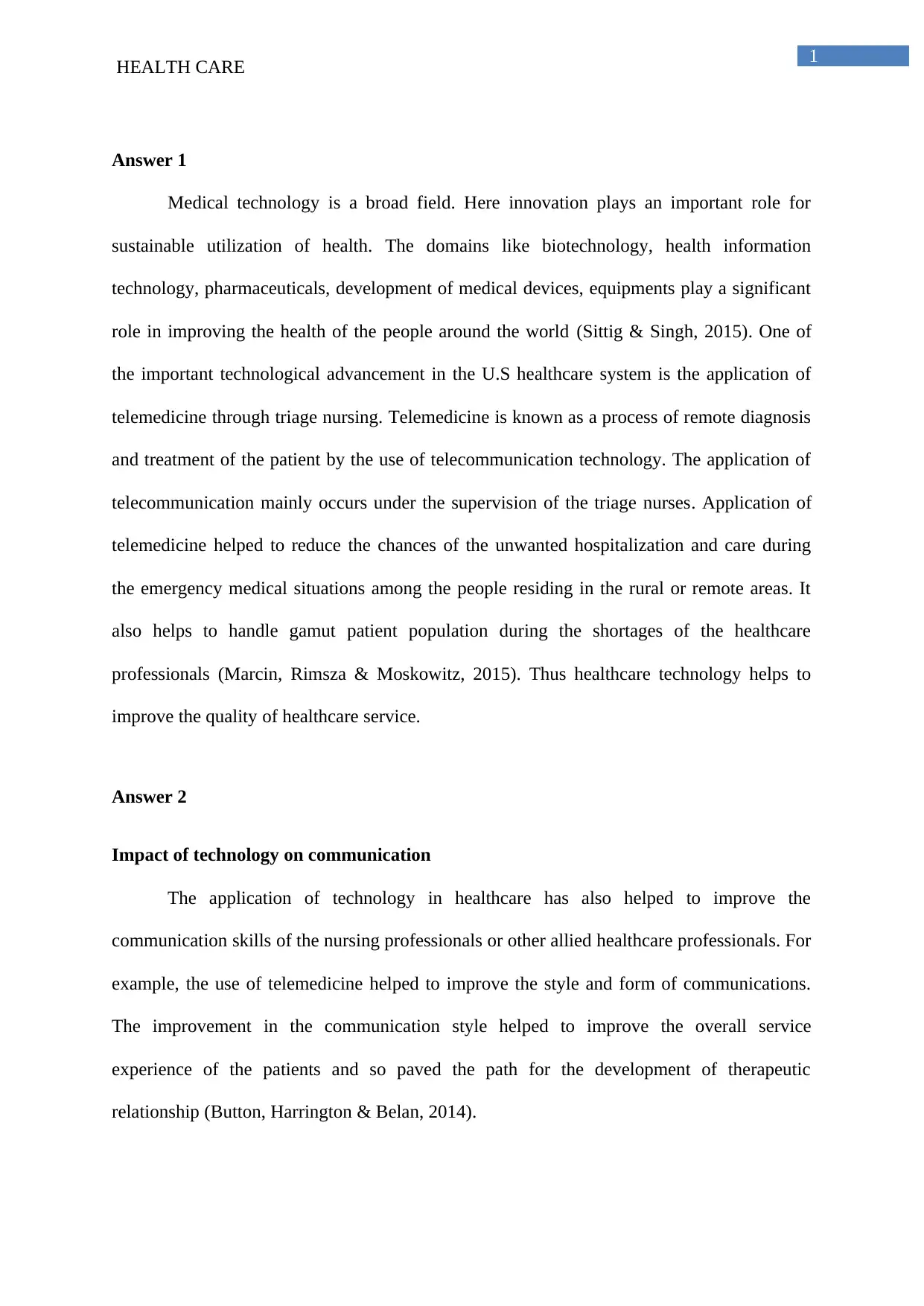
1
HEALTH CARE
Answer 1
Medical technology is a broad field. Here innovation plays an important role for
sustainable utilization of health. The domains like biotechnology, health information
technology, pharmaceuticals, development of medical devices, equipments play a significant
role in improving the health of the people around the world (Sittig & Singh, 2015). One of
the important technological advancement in the U.S healthcare system is the application of
telemedicine through triage nursing. Telemedicine is known as a process of remote diagnosis
and treatment of the patient by the use of telecommunication technology. The application of
telecommunication mainly occurs under the supervision of the triage nurses. Application of
telemedicine helped to reduce the chances of the unwanted hospitalization and care during
the emergency medical situations among the people residing in the rural or remote areas. It
also helps to handle gamut patient population during the shortages of the healthcare
professionals (Marcin, Rimsza & Moskowitz, 2015). Thus healthcare technology helps to
improve the quality of healthcare service.
Answer 2
Impact of technology on communication
The application of technology in healthcare has also helped to improve the
communication skills of the nursing professionals or other allied healthcare professionals. For
example, the use of telemedicine helped to improve the style and form of communications.
The improvement in the communication style helped to improve the overall service
experience of the patients and so paved the path for the development of therapeutic
relationship (Button, Harrington & Belan, 2014).
HEALTH CARE
Answer 1
Medical technology is a broad field. Here innovation plays an important role for
sustainable utilization of health. The domains like biotechnology, health information
technology, pharmaceuticals, development of medical devices, equipments play a significant
role in improving the health of the people around the world (Sittig & Singh, 2015). One of
the important technological advancement in the U.S healthcare system is the application of
telemedicine through triage nursing. Telemedicine is known as a process of remote diagnosis
and treatment of the patient by the use of telecommunication technology. The application of
telecommunication mainly occurs under the supervision of the triage nurses. Application of
telemedicine helped to reduce the chances of the unwanted hospitalization and care during
the emergency medical situations among the people residing in the rural or remote areas. It
also helps to handle gamut patient population during the shortages of the healthcare
professionals (Marcin, Rimsza & Moskowitz, 2015). Thus healthcare technology helps to
improve the quality of healthcare service.
Answer 2
Impact of technology on communication
The application of technology in healthcare has also helped to improve the
communication skills of the nursing professionals or other allied healthcare professionals. For
example, the use of telemedicine helped to improve the style and form of communications.
The improvement in the communication style helped to improve the overall service
experience of the patients and so paved the path for the development of therapeutic
relationship (Button, Harrington & Belan, 2014).
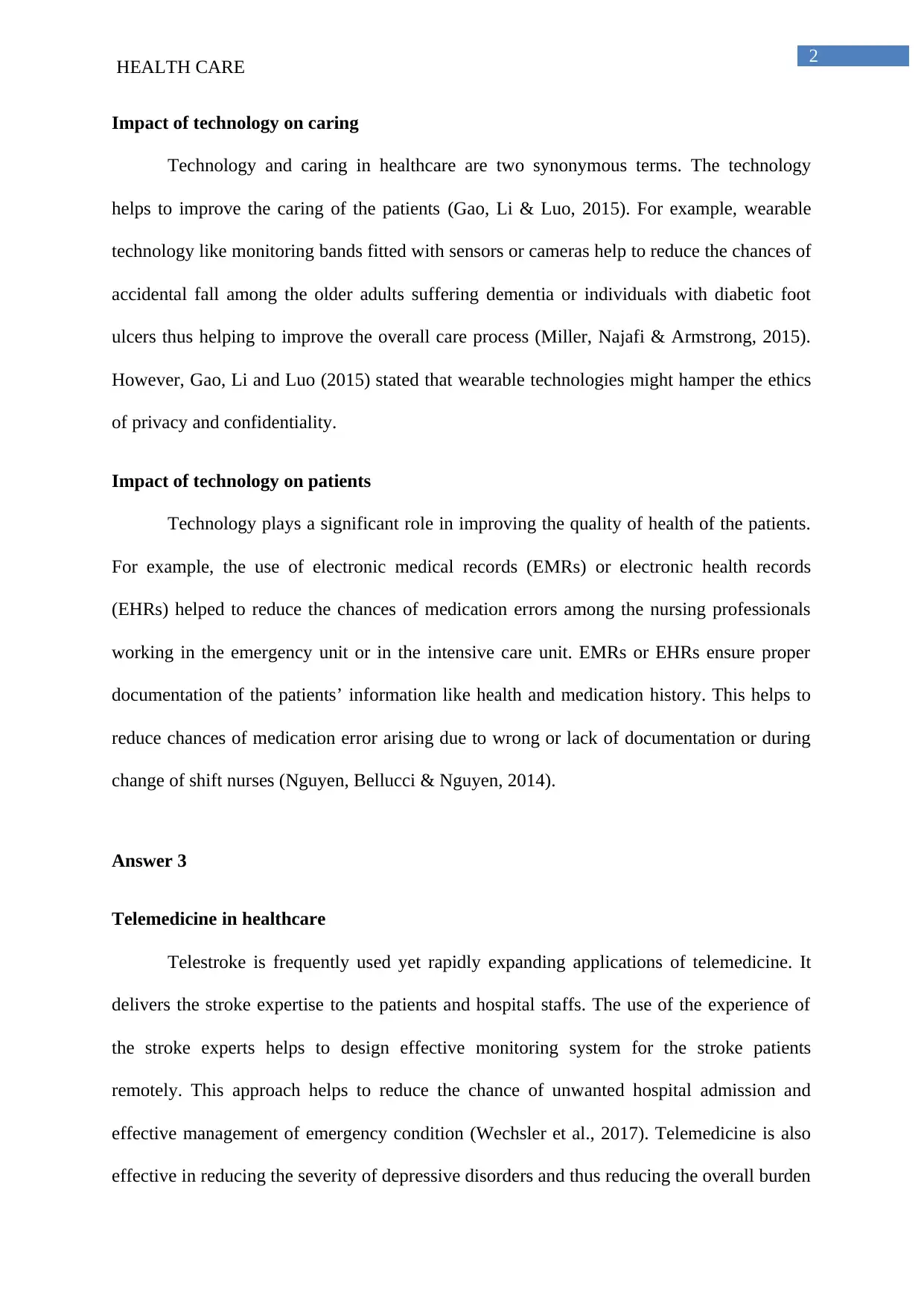
2
HEALTH CARE
Impact of technology on caring
Technology and caring in healthcare are two synonymous terms. The technology
helps to improve the caring of the patients (Gao, Li & Luo, 2015). For example, wearable
technology like monitoring bands fitted with sensors or cameras help to reduce the chances of
accidental fall among the older adults suffering dementia or individuals with diabetic foot
ulcers thus helping to improve the overall care process (Miller, Najafi & Armstrong, 2015).
However, Gao, Li and Luo (2015) stated that wearable technologies might hamper the ethics
of privacy and confidentiality.
Impact of technology on patients
Technology plays a significant role in improving the quality of health of the patients.
For example, the use of electronic medical records (EMRs) or electronic health records
(EHRs) helped to reduce the chances of medication errors among the nursing professionals
working in the emergency unit or in the intensive care unit. EMRs or EHRs ensure proper
documentation of the patients’ information like health and medication history. This helps to
reduce chances of medication error arising due to wrong or lack of documentation or during
change of shift nurses (Nguyen, Bellucci & Nguyen, 2014).
Answer 3
Telemedicine in healthcare
Telestroke is frequently used yet rapidly expanding applications of telemedicine. It
delivers the stroke expertise to the patients and hospital staffs. The use of the experience of
the stroke experts helps to design effective monitoring system for the stroke patients
remotely. This approach helps to reduce the chance of unwanted hospital admission and
effective management of emergency condition (Wechsler et al., 2017). Telemedicine is also
effective in reducing the severity of depressive disorders and thus reducing the overall burden
HEALTH CARE
Impact of technology on caring
Technology and caring in healthcare are two synonymous terms. The technology
helps to improve the caring of the patients (Gao, Li & Luo, 2015). For example, wearable
technology like monitoring bands fitted with sensors or cameras help to reduce the chances of
accidental fall among the older adults suffering dementia or individuals with diabetic foot
ulcers thus helping to improve the overall care process (Miller, Najafi & Armstrong, 2015).
However, Gao, Li and Luo (2015) stated that wearable technologies might hamper the ethics
of privacy and confidentiality.
Impact of technology on patients
Technology plays a significant role in improving the quality of health of the patients.
For example, the use of electronic medical records (EMRs) or electronic health records
(EHRs) helped to reduce the chances of medication errors among the nursing professionals
working in the emergency unit or in the intensive care unit. EMRs or EHRs ensure proper
documentation of the patients’ information like health and medication history. This helps to
reduce chances of medication error arising due to wrong or lack of documentation or during
change of shift nurses (Nguyen, Bellucci & Nguyen, 2014).
Answer 3
Telemedicine in healthcare
Telestroke is frequently used yet rapidly expanding applications of telemedicine. It
delivers the stroke expertise to the patients and hospital staffs. The use of the experience of
the stroke experts helps to design effective monitoring system for the stroke patients
remotely. This approach helps to reduce the chance of unwanted hospital admission and
effective management of emergency condition (Wechsler et al., 2017). Telemedicine is also
effective in reducing the severity of depressive disorders and thus reducing the overall burden
⊘ This is a preview!⊘
Do you want full access?
Subscribe today to unlock all pages.

Trusted by 1+ million students worldwide
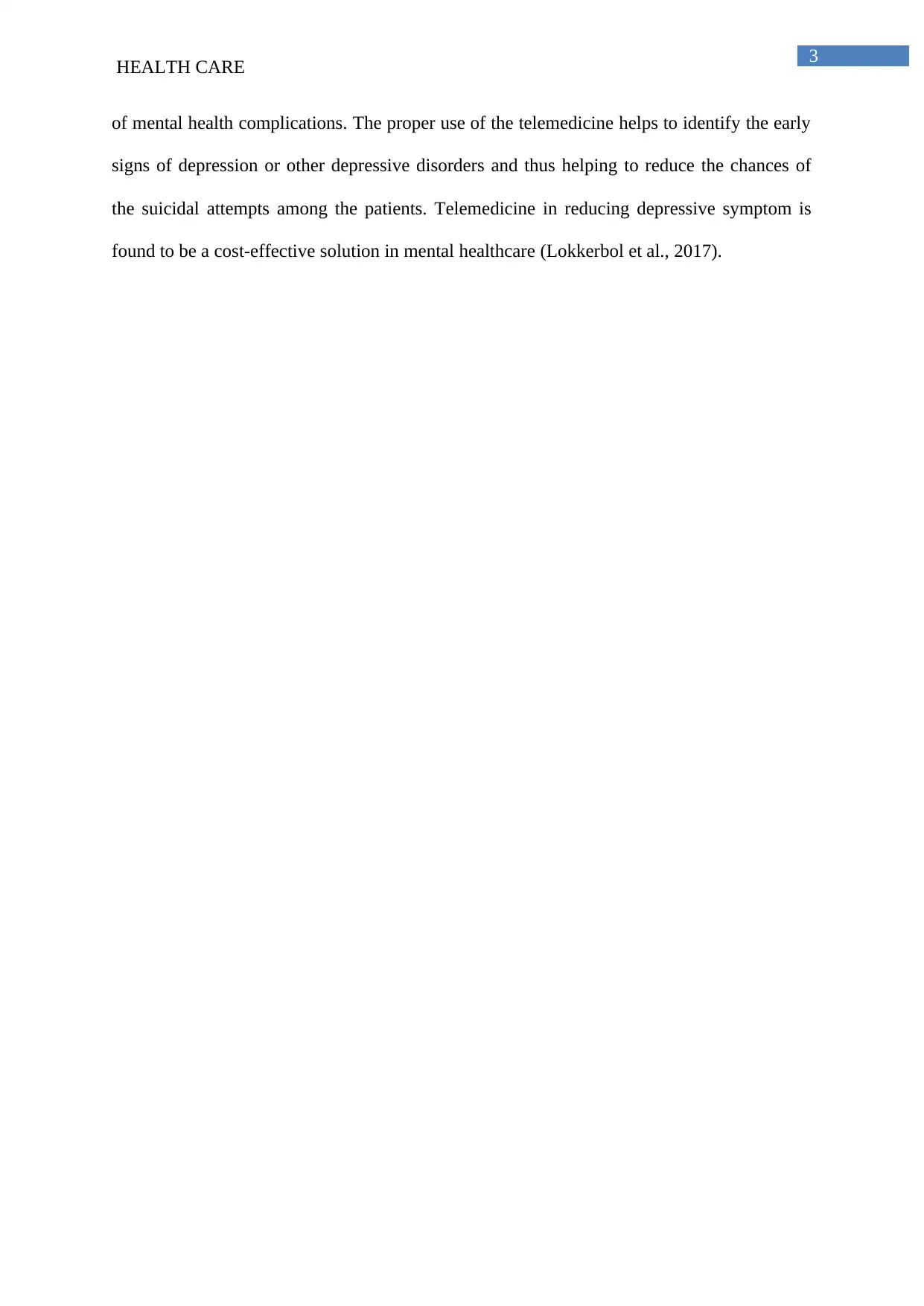
3
HEALTH CARE
of mental health complications. The proper use of the telemedicine helps to identify the early
signs of depression or other depressive disorders and thus helping to reduce the chances of
the suicidal attempts among the patients. Telemedicine in reducing depressive symptom is
found to be a cost-effective solution in mental healthcare (Lokkerbol et al., 2017).
HEALTH CARE
of mental health complications. The proper use of the telemedicine helps to identify the early
signs of depression or other depressive disorders and thus helping to reduce the chances of
the suicidal attempts among the patients. Telemedicine in reducing depressive symptom is
found to be a cost-effective solution in mental healthcare (Lokkerbol et al., 2017).
Paraphrase This Document
Need a fresh take? Get an instant paraphrase of this document with our AI Paraphraser
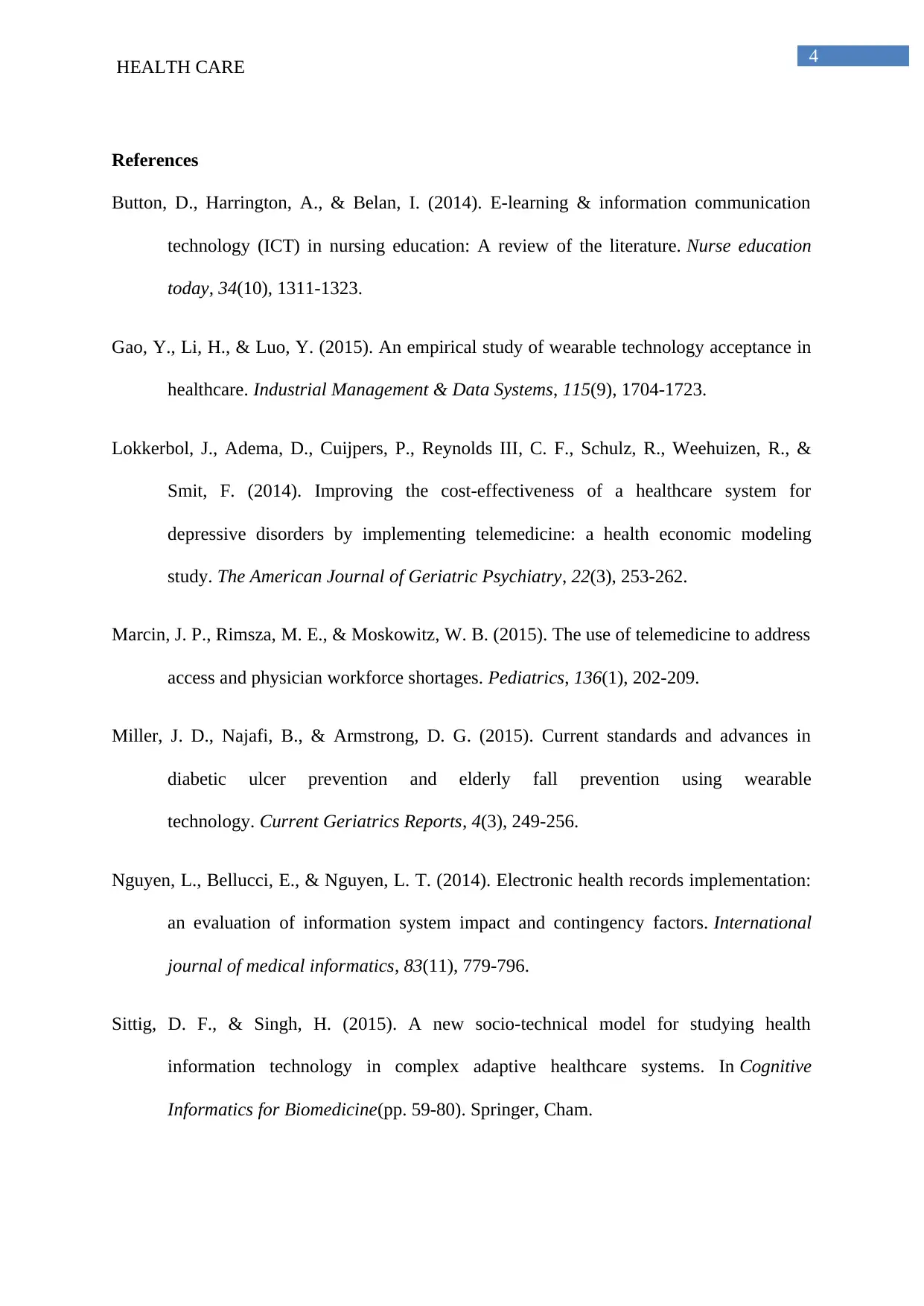
4
HEALTH CARE
References
Button, D., Harrington, A., & Belan, I. (2014). E-learning & information communication
technology (ICT) in nursing education: A review of the literature. Nurse education
today, 34(10), 1311-1323.
Gao, Y., Li, H., & Luo, Y. (2015). An empirical study of wearable technology acceptance in
healthcare. Industrial Management & Data Systems, 115(9), 1704-1723.
Lokkerbol, J., Adema, D., Cuijpers, P., Reynolds III, C. F., Schulz, R., Weehuizen, R., &
Smit, F. (2014). Improving the cost-effectiveness of a healthcare system for
depressive disorders by implementing telemedicine: a health economic modeling
study. The American Journal of Geriatric Psychiatry, 22(3), 253-262.
Marcin, J. P., Rimsza, M. E., & Moskowitz, W. B. (2015). The use of telemedicine to address
access and physician workforce shortages. Pediatrics, 136(1), 202-209.
Miller, J. D., Najafi, B., & Armstrong, D. G. (2015). Current standards and advances in
diabetic ulcer prevention and elderly fall prevention using wearable
technology. Current Geriatrics Reports, 4(3), 249-256.
Nguyen, L., Bellucci, E., & Nguyen, L. T. (2014). Electronic health records implementation:
an evaluation of information system impact and contingency factors. International
journal of medical informatics, 83(11), 779-796.
Sittig, D. F., & Singh, H. (2015). A new socio-technical model for studying health
information technology in complex adaptive healthcare systems. In Cognitive
Informatics for Biomedicine(pp. 59-80). Springer, Cham.
HEALTH CARE
References
Button, D., Harrington, A., & Belan, I. (2014). E-learning & information communication
technology (ICT) in nursing education: A review of the literature. Nurse education
today, 34(10), 1311-1323.
Gao, Y., Li, H., & Luo, Y. (2015). An empirical study of wearable technology acceptance in
healthcare. Industrial Management & Data Systems, 115(9), 1704-1723.
Lokkerbol, J., Adema, D., Cuijpers, P., Reynolds III, C. F., Schulz, R., Weehuizen, R., &
Smit, F. (2014). Improving the cost-effectiveness of a healthcare system for
depressive disorders by implementing telemedicine: a health economic modeling
study. The American Journal of Geriatric Psychiatry, 22(3), 253-262.
Marcin, J. P., Rimsza, M. E., & Moskowitz, W. B. (2015). The use of telemedicine to address
access and physician workforce shortages. Pediatrics, 136(1), 202-209.
Miller, J. D., Najafi, B., & Armstrong, D. G. (2015). Current standards and advances in
diabetic ulcer prevention and elderly fall prevention using wearable
technology. Current Geriatrics Reports, 4(3), 249-256.
Nguyen, L., Bellucci, E., & Nguyen, L. T. (2014). Electronic health records implementation:
an evaluation of information system impact and contingency factors. International
journal of medical informatics, 83(11), 779-796.
Sittig, D. F., & Singh, H. (2015). A new socio-technical model for studying health
information technology in complex adaptive healthcare systems. In Cognitive
Informatics for Biomedicine(pp. 59-80). Springer, Cham.
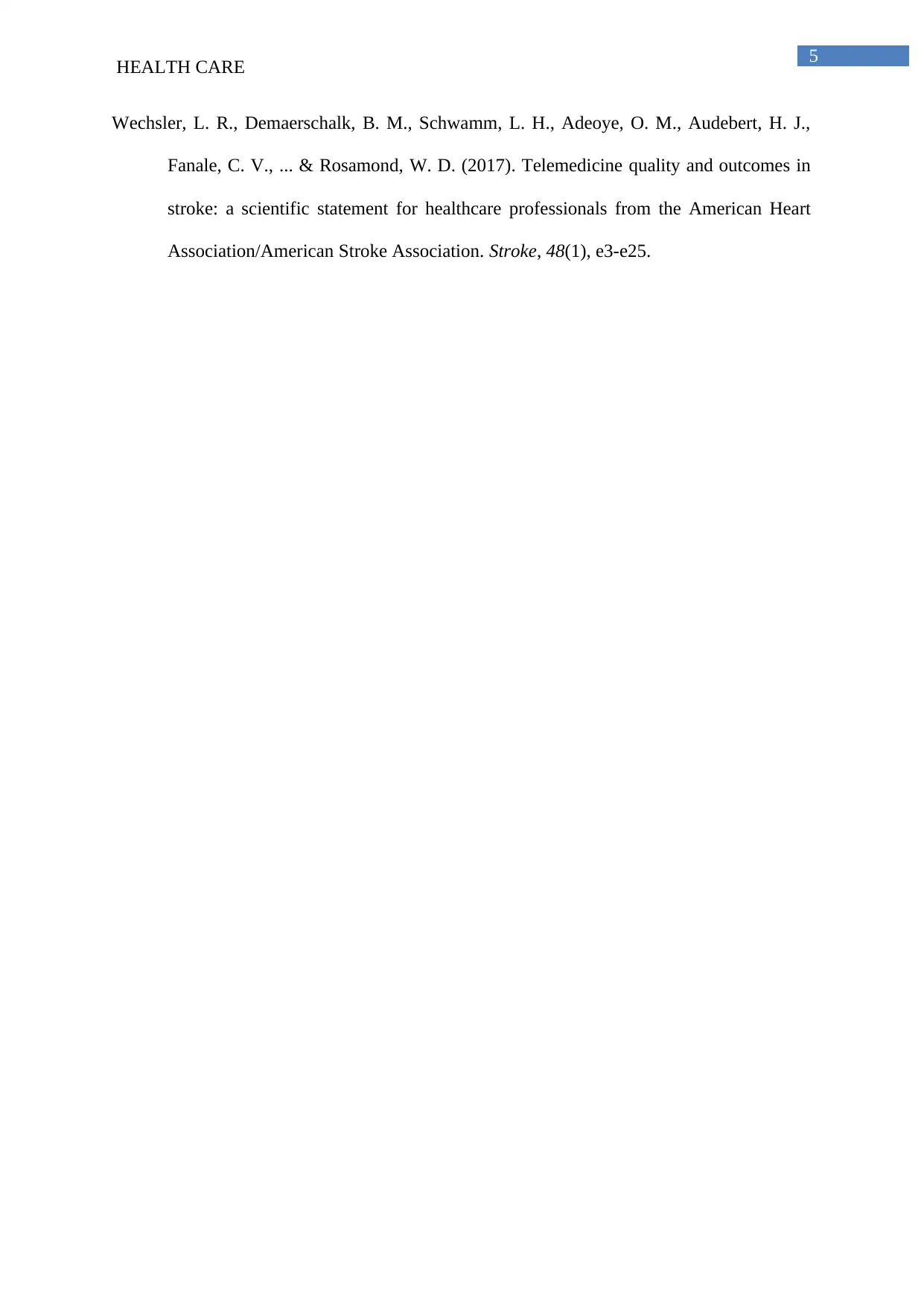
5
HEALTH CARE
Wechsler, L. R., Demaerschalk, B. M., Schwamm, L. H., Adeoye, O. M., Audebert, H. J.,
Fanale, C. V., ... & Rosamond, W. D. (2017). Telemedicine quality and outcomes in
stroke: a scientific statement for healthcare professionals from the American Heart
Association/American Stroke Association. Stroke, 48(1), e3-e25.
HEALTH CARE
Wechsler, L. R., Demaerschalk, B. M., Schwamm, L. H., Adeoye, O. M., Audebert, H. J.,
Fanale, C. V., ... & Rosamond, W. D. (2017). Telemedicine quality and outcomes in
stroke: a scientific statement for healthcare professionals from the American Heart
Association/American Stroke Association. Stroke, 48(1), e3-e25.
⊘ This is a preview!⊘
Do you want full access?
Subscribe today to unlock all pages.

Trusted by 1+ million students worldwide
1 out of 6
Related Documents
Your All-in-One AI-Powered Toolkit for Academic Success.
+13062052269
info@desklib.com
Available 24*7 on WhatsApp / Email
![[object Object]](/_next/static/media/star-bottom.7253800d.svg)
Unlock your academic potential
Copyright © 2020–2025 A2Z Services. All Rights Reserved. Developed and managed by ZUCOL.





